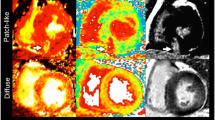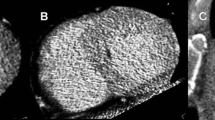Abstract
Contrast enhanced magnetic resonance imaging (CeMRI) reliably identifies myocardial fibrosis in patients with hypertrophic cardiomyopathy (HCM). However, many patients have contraindications to ceMRI. Previous studies have shown that contrast enhanced multi-detector computed tomography (ceMDCT) can visualize focal scars following myocardial infarction in experimental animals and patients. The purpose of this manuscript is to assess the ability of ceMDCT to detect focal myocardial scars in patients with HCM. Twelve HCM patients underwent ceMRI and ceMDCT. Fibrotic areas of myocardium were defined as focal or diffuse areas of fibrosis. The mean signal intensity in ceMRI and attenuation values in ceMDCT of the fibrotic regions, normal myocardium and left ventricle blood pool contrast were measured using qualitative and quantitative analysis. Focal scar mass was calculated using both techniques. Focal scars were detected in 9 patients and diffuse fibrosis was visualized in all patients by ceMRI. Differences between normalized SI of normal myocardium and focal scars, normal and diffuse areas of fibrosis, and diffuse fibrosis and focal scars were significant for both ceMRI and ceMDCT (p < 0.05). Diffuse fibrosis was poorly visualized by ceMDCT but was detectable using quantitative measurements. CeMDCT has potential to detect focal myocardial scars in patients with HCM who have contraindications to ceMRI study. However, ceMDCT does not enable adequate visualization of diffuse myocardial fibrosis, and thus is less well suited than ceMRI for assessment of total burden of fibrosis. This limitation may be overcome using quantitative methodology.






Similar content being viewed by others
References
Spirito P, Seidman CE, McKenna WJ et al (1997) The management of hypertrophic cardiomyopathy. N Engl J Med 336:775–785
Maron BJ, McKenna WJ, Danielson GK et al (2003) American College of Cardiology/European Society of Cardiology clinical expert consensus document on hypertrophic cardiomyopathy. A report of the American college of cardiology foundation task force on clinical expert consensus documents and the European society of cardiology committee for practice guidelines. J Am Coll Cardiol 42:1687–1713
Maron BJ (2002) Cardiology patient pages. Hypertrophic cardiomyopathy. Circulation 106:2419–2421
Choudhury L, Mahrholdt H, Wagner A et al (2002) Myocardial scarring in asymptomatic or mildly symptomatic patients with hypertrophic cardiomyopathy. J Am Coll Cardiol 40:2156–2164
Adabag AS, Maron BJ, Appelbaum E et al (2008) Occurrence and frequency of arrhythmias in hypertrophic cardiomyopathy in relation to delayed enhancement on cardiovascular magnetic resonance. J Am Coll Cardiol 51:1369–1374
Varnava AM, Elliott PM, Mahon N et al (2001) Relation between myocyte disarray and outcome in hypertrophic cardiomyopathy. Am J Cardiol 88:275–279
Maron BJ (1997) Hypertrophic cardiomyopathy. Lancet 350:127–133
Lima JA, Judd RM, Bazille A et al (1995) Regional heterogeneity of human myocardial infarcts demonstrated by contrast-enhanced MRI. Potential mechanisms. Circulation 92:1117–1125
Moon JC, Sievers B, Pennell DJ et al (2003) Myocardial scarring caused by left ventricular assist device (LVAD) insertion demonstrated by cardiovascular magnetic resonance. J Cardiovasc Magn Reson 5:361–363
Gerber BL, Belge B, Legros GJ et al (2006) Characterization of acute and chronic myocardial infarcts by multidetector computed tomography: comparison with contrast-enhanced magnetic resonance. Circulation 113:823–833
Baks T, Cademartiri F, Moelker AD et al (2006) Multislice computed tomography and magnetic resonance imaging for the assessment of reperfused acute myocardial infarction. J Am Coll Cardiol 48:144–152
Mahnken AH, Katoh M, Bruners P et al (2005) Acute myocardial infarction: assessment of left ventricular function with 16-detector row spiral CT versus MR imaging—study in pigs. Radiology 236:112–117
Christner JA, Kofler JM, McCollough CH (2010) Estimating effective dose for CT using dose-length product compared with using organ doses: consequences of adopting International Commission on Radiological Protection publication 103 or dual-energy scanning. AJR Am J Roentgenol 194:881–889
Moon JC, McKenna WJ, McCrohon JA et al (2003) Toward clinical risk assessment in hypertrophic cardiomyopathy with gadolinium cardiovascular magnetic resonance. J Am Coll Cardiol 41:1561–1567
Sandstede J, Lipke C, Beer M et al (2000) Age- and gender-specific differences in left and right ventricular cardiac function and mass determined by cine magnetic resonance imaging. Eur Radiol 10:438–442
Simor T, Suranyi P, Ruzsics B et al (2010) Percent infarct mapping for delayed contrast enhancement magnetic resonance imaging to quantify myocardial viability by Gd(DTPA). J Magn Reson Imaging 32:859–868
Krombach GA, Niendorf T, Gunther RW et al (2007) Characterization of myocardial viability using MR and CT imaging. Eur Radiol 17:1433–1444
Saito H, Naito H, Takamiya M et al (1991) Late enhancement of the left ventricular wall in hypertrophic cardiomyopathy by ultrafast computed tomography: a comparison with regional myocardial thickening. Br J Radiol 64:993–1000
Maron MS, Appelbaum E, Harrigan CJ et al (2008) Clinical profile and significance of delayed enhancement in hypertrophic cardiomyopathy. Circ Heart Fail 1:184–191
Shiozaki AA, Kim RJ, Parga JR et al (2007) Cardiovascular magnetic resonance in hypertrophic cardiomyopathy. Arq Bras Cardiol 88:243–248
Yan AT, Shayne AJ, Brown KA et al (2006) Characterization of the peri-infarct zone by contrast-enhanced cardiac magnetic resonance imaging is a powerful predictor of post-myocardial infarction mortality. Circulation 114:32–39
Roes SD, Borleffs CJ, van der Geest RJ et al (2009) Infarct tissue heterogeneity assessed with contrast-enhanced MRI predicts spontaneous ventricular arrhythmia in patients with ischemic cardiomyopathy and implantable cardioverter-defibrillator. Circ Cardiovasc Imaging 2:183–190
Kwon DH, Smedira NG, Rodriguez ER et al (2009) Cardiac magnetic resonance detection of myocardial scarring in hypertrophic cardiomyopathy: correlation with histopathology and prevalence of ventricular tachycardia. J Am Coll Cardiol 54:242–249
O’Hanlon R, Grasso A, Roughton M et al (2010) Prognostic significance of myocardial fibrosis in hypertrophic cardiomyopathy. J Am Coll Cardiol 56:867–874
Bruder O, Wagner A, Jensen CJ et al (2010) Myocardial scar visualized by cardiovascular magnetic resonance imaging predicts major adverse events in patients with hypertrophic cardiomyopathy. J Am Coll Cardiol 56:875–887
Iles L, Pfluger H, Phrommintikul A et al (2008) Evaluation of diffuse myocardial fibrosis in heart failure with cardiac magnetic resonance contrast-enhanced T1 mapping. J Am Coll Cardiol 52:1574–1580
Conflict of interest
All the authors of the manuscript (Jennifer I. Berliner MD, FACC, Aya Kino MD, James C. Carr, MD, Robert O. Bonow, MD,MACC, Lubna Choudhury, MB BCh, MD, MRCP, FACC) does not have nothing to disclosure and have full control of all primary data and also allow the journal to review the data if requested.
Author information
Authors and Affiliations
Corresponding author
Additional information
Jennifer I. Berliner and Aya Kino contributed equally to this article.
Rights and permissions
About this article
Cite this article
Berliner, J.I., Kino, A., Carr, J.C. et al. Cardiac computed tomographic imaging to evaluate myocardial scarring/fibrosis in patients with hypertrophic cardiomyopathy: a comparison with cardiac magnetic resonance imaging. Int J Cardiovasc Imaging 29, 191–197 (2013). https://doi.org/10.1007/s10554-012-0048-y
Received:
Accepted:
Published:
Issue Date:
DOI: https://doi.org/10.1007/s10554-012-0048-y




